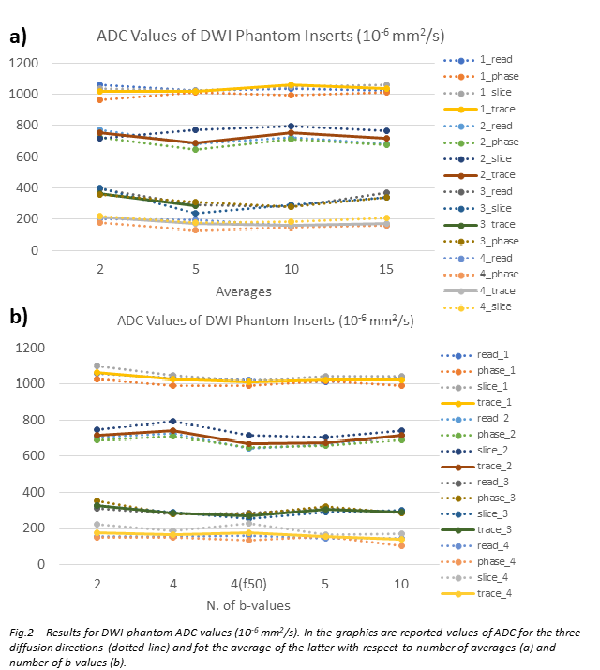Physical characterization of an EPI DWI sequence for implementation of onboard tool in MR-linac
PO-1682
Abstract
Physical characterization of an EPI DWI sequence for implementation of onboard tool in MR-linac
Authors: Matteo Nardini1, Lorenzo Nicola Mazzoni2, Matteo Galetto1, Amedeo Capotosti1, Andrea Fidanzio1, Luca Boldrini3, Giuditta Chiloiro3, Angela Romano3, Giulia Panza3, Claudio Votta3, Gabriele Turco3, Roberto Moretti1, Luca Indovina1, Lorenzo Placidi1
1Fondazione Policlinico Universitario ‘‘A. Gemelli’’ IRCCS, UOSD Fisica Medica e Radioprotezione, Roma, Italy; 2Azienda USL Toscana Centro, Unità di Fisica Medica, Prato-Pistoia, Italy; 3Fondazione Policlinico Universitario ‘‘A. Gemelli’’ IRCCS, UOC Radioterapia Oncologica, Roma, Italy
Show Affiliations
Hide Affiliations
Purpose or Objective
In the field of hybrid accelerators with MR, online adaptive RT represents the frontier of treatment customisation. The possibility of acquiring diffusion images at each fraction would allow the acquisition of quantitative information useful for the evaluation of therapy progress, dose painting and the extraction of radiomic features. The aim of this study is the physical evaluation of the parameters of a sequence for diffusion imaging at a 0.35 T scanner to become feasible in a typical online adaptive MRgRT clinical workflow.
Material and Methods
Diffusion sequences were acquired using a uniform spherical (SP) filled with aqueous nickel chloride hexahydrate solution and another specifically realised for diffusion measurements (DWI phantom) with four inserts with certified ADC values. Images were acquired on both phantoms by varying number of averages, b-values and slice thickness while keeping the others unchanged. The relative ADC maps (4 maps for each acquisition considering 3 gradient direction and the average of the latter) were then calculated using a single-exponential model. On these maps, mean values of ADC, SNR and uniformity were evaluated to find the best combination of parameters considering the acquisition time. In addition, a repeatability test was performed, acquiring two identical sequences under the same temperature and humidity conditions 24 hours apart.
Results
Results obtained for the SP are shown in Fig1. SNR (panels 'a' and 'd') seems to grow proportionally to slice thickness and averages, although in the latter case the growth seems to stop after 10 averages. The same can be deduced for the uniformity trend (panels "b" and "e"). ADC value this seems to be strongly underestimated with respect to the reference value (1600-2000 10^-6 mm^2/s - Italian survey on 1.5-3.0 T scanners) until the 6 mm value is reached (panel "c"). The ADC value appears to be unaffected by the number of averages used in the sequence (panel “f”). Acquisition times as a function of the number of averages vary between 26 s (1 av.) and 390 s (15 av.) while remain unchanged for slice thicknesses. Results for the DWI phantom are summarised in Fig2. The ADC values for the 4 inserts do not seem to depend on either the number of averages (panel “a”) or the number of b-values (panel “b”). For the repeatability the result is that the difference in ADC values between the two measurements is compatible with the background within the experimental errors. The average of the ADC values obtained for each of the 4 inserts results to be (mean (standard dev.) 10^-6 mm^2/s):
insert 1: 1007(90), insert 2: 719(75), insert 3: 302(100), insert 4: 178(65)
to compare with 1900, 1450, 1000 and 500 10^-6 mm^2/s respectively.


Conclusion
In light of the measurements performed, the diffusion sequence with EPI scheme is feasible in an adaptive MRgRT workflow considering acquisition with 10 averages and 4 b-values. The fact remains that the calculated ADC values seem to underestimate those obtained with higher-field scanners.